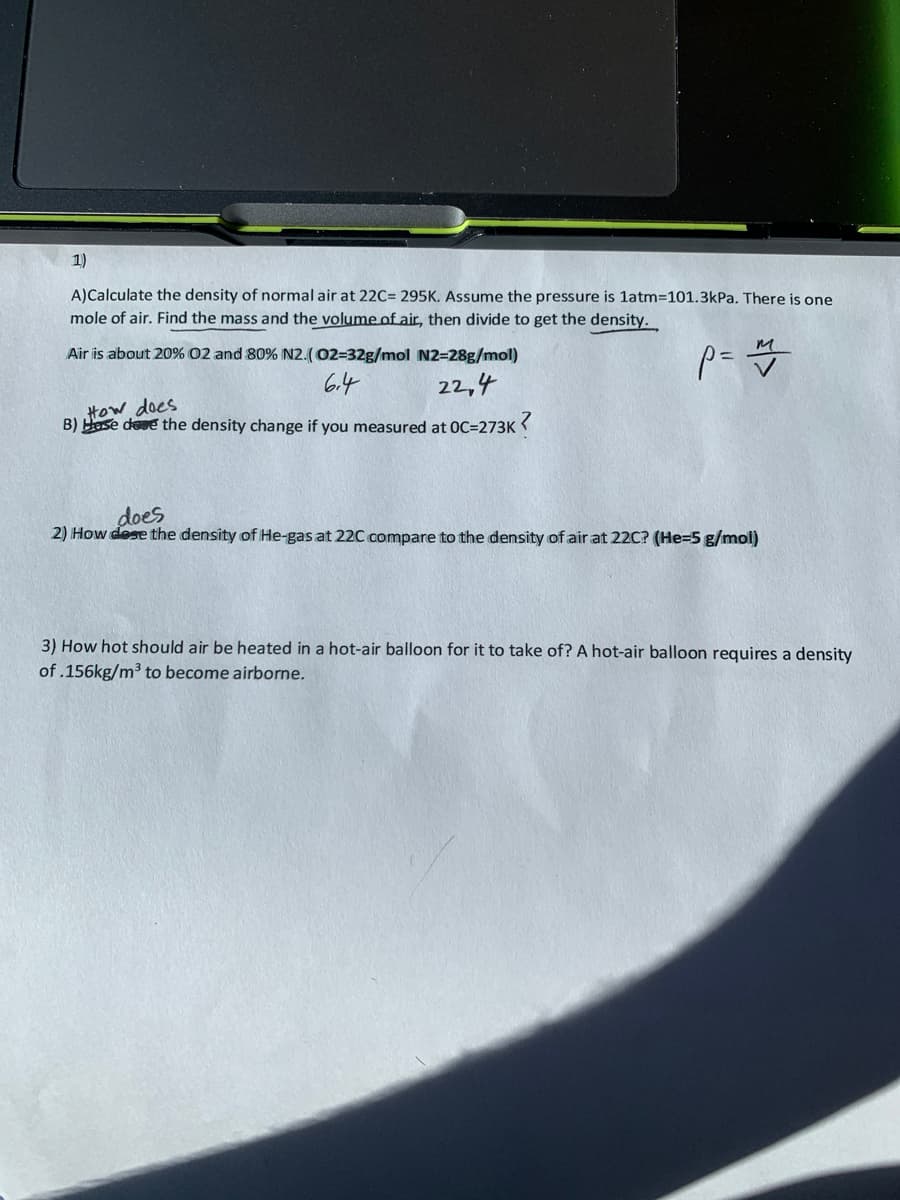A)Calculate the density of normal air at 22C= 295K. Assume the pressure is 1atm=101.3kPa. There is one mole of air. Find the mass and the volume of air, then divide to get the density. Air is about 20% 02 and 80% N2.(02=32g/mol N2=28g/mol) 6.4 22,4 tow does B) Hese dese the density change if you measured at 0C=273K
A)Calculate the density of normal air at 22C= 295K. Assume the pressure is 1atm=101.3kPa. There is one mole of air. Find the mass and the volume of air, then divide to get the density. Air is about 20% 02 and 80% N2.(02=32g/mol N2=28g/mol) 6.4 22,4 tow does B) Hese dese the density change if you measured at 0C=273K
Introduction to Chemical Engineering Thermodynamics
8th Edition
ISBN:9781259696527
Author:J.M. Smith Termodinamica en ingenieria quimica, Hendrick C Van Ness, Michael Abbott, Mark Swihart
Publisher:J.M. Smith Termodinamica en ingenieria quimica, Hendrick C Van Ness, Michael Abbott, Mark Swihart
Chapter1: Introduction
Section: Chapter Questions
Problem 1.1P
Related questions
Question
Solve #1

Transcribed Image Text:1)
A)Calculate the density of normal air at 22C= 295K. Assume the pressure is 1atm=101.3kPa. There is one
mole of air. Find the mass and the volume of air, then divide to get the density.
Air is about 20% 02 and 80% N2.(02=32g/mol N2=28g/mol)
6.4
22,4
How does
B) Hase deve the density change if you measured at OC=273K
does
2) How dese the density of He-gas at 22C compare to the density of air at 22C? (He=5 g/mol)
3) How hot should air be heated in a hot-air balloon for it to take of? A hot-air balloon requires a density
of .156kg/m3 to become airborne.
Expert Solution
This question has been solved!
Explore an expertly crafted, step-by-step solution for a thorough understanding of key concepts.
This is a popular solution!
Trending now
This is a popular solution!
Step by step
Solved in 3 steps with 5 images

Knowledge Booster
Learn more about
Need a deep-dive on the concept behind this application? Look no further. Learn more about this topic, chemical-engineering and related others by exploring similar questions and additional content below.Recommended textbooks for you

Introduction to Chemical Engineering Thermodynami…
Chemical Engineering
ISBN:
9781259696527
Author:
J.M. Smith Termodinamica en ingenieria quimica, Hendrick C Van Ness, Michael Abbott, Mark Swihart
Publisher:
McGraw-Hill Education

Elementary Principles of Chemical Processes, Bind…
Chemical Engineering
ISBN:
9781118431221
Author:
Richard M. Felder, Ronald W. Rousseau, Lisa G. Bullard
Publisher:
WILEY

Elements of Chemical Reaction Engineering (5th Ed…
Chemical Engineering
ISBN:
9780133887518
Author:
H. Scott Fogler
Publisher:
Prentice Hall

Introduction to Chemical Engineering Thermodynami…
Chemical Engineering
ISBN:
9781259696527
Author:
J.M. Smith Termodinamica en ingenieria quimica, Hendrick C Van Ness, Michael Abbott, Mark Swihart
Publisher:
McGraw-Hill Education

Elementary Principles of Chemical Processes, Bind…
Chemical Engineering
ISBN:
9781118431221
Author:
Richard M. Felder, Ronald W. Rousseau, Lisa G. Bullard
Publisher:
WILEY

Elements of Chemical Reaction Engineering (5th Ed…
Chemical Engineering
ISBN:
9780133887518
Author:
H. Scott Fogler
Publisher:
Prentice Hall


Industrial Plastics: Theory and Applications
Chemical Engineering
ISBN:
9781285061238
Author:
Lokensgard, Erik
Publisher:
Delmar Cengage Learning

Unit Operations of Chemical Engineering
Chemical Engineering
ISBN:
9780072848236
Author:
Warren McCabe, Julian C. Smith, Peter Harriott
Publisher:
McGraw-Hill Companies, The